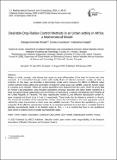| dc.contributor.author | Renalda, Edwiga Kishinda | |
| dc.contributor.author | Kuznetsov, Dmitry | |
| dc.contributor.author | Kreppel, Katharina | |
| dc.date.accessioned | 2020-10-13T12:27:57Z | |
| dc.date.available | 2020-10-13T12:27:57Z | |
| dc.date.issued | 2020-02-08 | |
| dc.identifier.uri | https://doi.org/10.5815/ijmsc.2020.01.05 | |
| dc.identifier.uri | https://dspace.nm-aist.ac.tz/handle/20.500.12479/989 | |
| dc.description | This research article published by Modern Education and Computer Science Press, 2020 | en_US |
| dc.description.abstract | Rabies is a fatal, zoonotic, viral disease that causes an acute inflammation of the brain in humans and other
mammals. It is transmitted through contact with bodily fluids of infected mammals, usually via bites or
scratches. In this paper, we formulate a deterministic model which measures the effects of different rabies
control methods (mass-culling and vaccination of dogs) for urban areas near wildlife, using the Arusha region
in Tanzania as an example. Values for various parameters were deduced from five years’ worth of survey data
on Arusha’s dog population. Data included vaccination coverage, dog bites and rabies deaths recorded by a
local non-governmental organization and the Ministry of Agriculture, Livestock Development and Fisheries of
the United Republic of Tanzania. The basic reproduction number R0 and effective reproduction number Re
were computed and found to be 1.9 and 1.2 respectively. These imply that the disease is endemic in Arusha.
The numerical simulation of the reproduction number shows that vaccination is the most appropriate control
method for rabies transmission in urban areas near wildlife reservoirs. The disease free equilibrium ε0 is also
computed. If the effective reproduction number Re is computed and found to be less than 1, it implies that it is
globally asymptotically stable in the feasible region Φ. If Re > 1 it is implied that there is one equilibrium
point which is endemic and it is locally asymptotically stable. | en_US |
| dc.language.iso | en | en_US |
| dc.publisher | Modern Education and Computer Science Press | en_US |
| dc.subject | Culling for Dog Control | en_US |
| dc.subject | SEIV-Model | en_US |
| dc.subject | Reproduction Number | en_US |
| dc.title | Desirable Dog-Rabies Control Methods in an Urban setting in Africa - a Mathematical Model | en_US |
| dc.type | Article | en_US |

